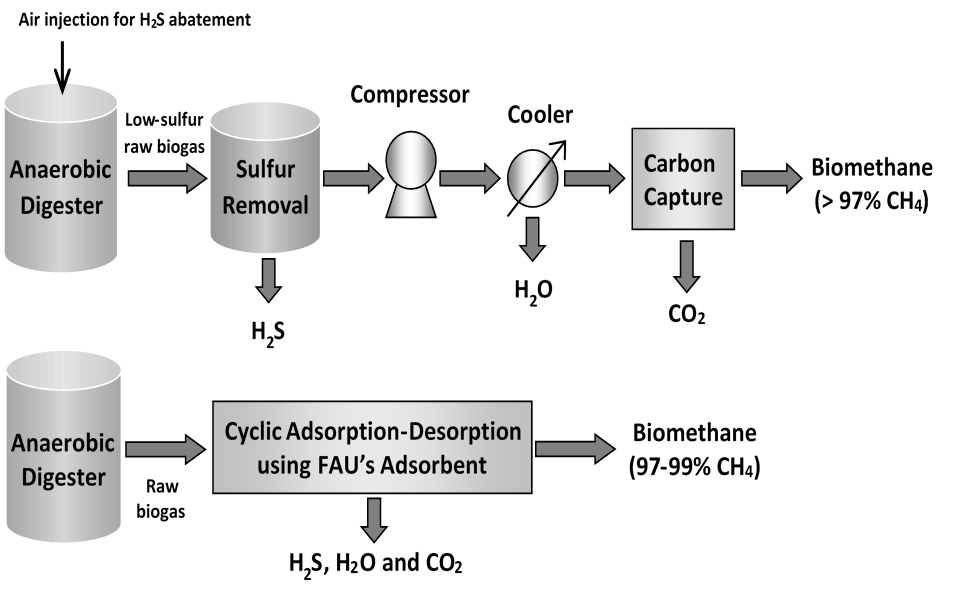 Project Summary: Biogas is a carbon-neutral source of renewable energy that may be produced by anaerobic digestion of agricultural waste or collected in landfills. In addition to methane, biogas contains carbon dioxide and other ubiquitous impurities such as water vapor and hydrogen sulfide. Hence, biogas purification, to produce biomethane, is required prior to using it as transportation fuel or injecting it into natural gas grid. Whereas current biogas upgrading processes require multiple upstream units for desulfurization, drying, and biogas compression or cooling before carbon dioxide removal, we hypothesize that FAU’s amine-modified silica adsorbents can concurrently separate all impurities. Thus, the objective of this research is to purify biogas in one single step using FAU’s made-to-order adsorbent materials. This research is of strategic importance to the U.S. energy security and well-being and prosperity of our small/rural communities and is in line with Environmental Protection Agency’s (EPA) commitment to curb our emissions, to protect the environment, and to support environmentally sustainable technologies. Our proposed process drastically simplifies biogas upgrading using adsorbent materials engineered specifically to produce grid-quality biomethane. This innovative technology is comprised of concurrent removal of carbon dioxide, hydrogen sulfide and water vapor from the feed gas, followed by adsorbent regeneration and cooling in air before starting the subsequent cycle. Since the end users are the disadvantaged rural/small communities across the U.S. and landfill facilities, which are operating through taxpayers’ money, cost efficiency is critical to ensure the viability of the technology. To address this critical piece, cost considerations have been factored in throughout the experimental design by choosing inexpensive silica as support, utilizing hot air as the cheapest purge gas available, and maximizing adsorbent lifetime through material design.
Project Summary: Biogas is a carbon-neutral source of renewable energy that may be produced by anaerobic digestion of agricultural waste or collected in landfills. In addition to methane, biogas contains carbon dioxide and other ubiquitous impurities such as water vapor and hydrogen sulfide. Hence, biogas purification, to produce biomethane, is required prior to using it as transportation fuel or injecting it into natural gas grid. Whereas current biogas upgrading processes require multiple upstream units for desulfurization, drying, and biogas compression or cooling before carbon dioxide removal, we hypothesize that FAU’s amine-modified silica adsorbents can concurrently separate all impurities. Thus, the objective of this research is to purify biogas in one single step using FAU’s made-to-order adsorbent materials. This research is of strategic importance to the U.S. energy security and well-being and prosperity of our small/rural communities and is in line with Environmental Protection Agency’s (EPA) commitment to curb our emissions, to protect the environment, and to support environmentally sustainable technologies. Our proposed process drastically simplifies biogas upgrading using adsorbent materials engineered specifically to produce grid-quality biomethane. This innovative technology is comprised of concurrent removal of carbon dioxide, hydrogen sulfide and water vapor from the feed gas, followed by adsorbent regeneration and cooling in air before starting the subsequent cycle. Since the end users are the disadvantaged rural/small communities across the U.S. and landfill facilities, which are operating through taxpayers’ money, cost efficiency is critical to ensure the viability of the technology. To address this critical piece, cost considerations have been factored in throughout the experimental design by choosing inexpensive silica as support, utilizing hot air as the cheapest purge gas available, and maximizing adsorbent lifetime through material design.

|
|
Current multi-stage biogas upgrading technologies (top) versus the proposed single-stage process(bottom).
|